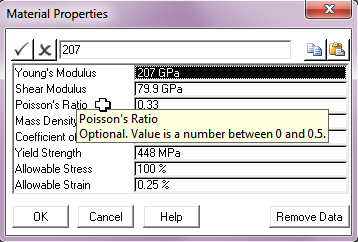There are two types of input dialog in the PipeLay GUI – the List Type and the Spreadsheet Type. The following sub-sections describe the operation each of these dialogs in turn.
These dialogs are for the entry of simple lists of parameters. A sample list-type dialog is shown in the figure below.

Sample List-Type Dialog
To set the value of a parameter, it is first selected from the list by clicking on it. Where there is a default value available for a parameter, it is shown greyed. Its value may then be changed by either typing the new value into the box at the top of the dialog, or selecting a value from the drop-down list presented, as appropriate. When entering a value at the top of the dialog, the ![]() buttons may be used to respectively confirm or cancel the entry. Pressing the Return key will also confirm the entry.
buttons may be used to respectively confirm or cancel the entry. Pressing the Return key will also confirm the entry.
The copy and paste buttons ![]() located at the top right of the dialog allow you to copy the contents of the dialog as plain text. Each entry on the dialog is copied as a separate line.
located at the top right of the dialog allow you to copy the contents of the dialog as plain text. Each entry on the dialog is copied as a separate line.
The appropriate units are automatically appended to the value in the parameter display box. Further information on the PipeLay units system can be found in ‘Project Component’.
If you hover your mouse pointer over the name of any of the inputs down the left-hand-side of the dialog, as shown in the figure below, a small window is displayed showing some extra information about the parameter in question.

Parameter Information (List-Type)
The buttons at the bottom of the dialog are used as follows:
Button |
Description |
OK |
Confirm the data entered and close the dialog. |
Cancel |
Close the dialog, discarding any changes made. |
Remove Data |
Clear the contents of the dialog, restoring all the parameters to their default values. |
The spreadsheet type dialogs are in many ways similar to the simple list type dialogs. The major difference is that this dialog allows several sets of the same kind of data to be input. A sample spreadsheet-type dialog is shown in the figure below. Please note that spreadsheet type dialogs may be resized by dragging any of the corners of the dialog. This is very convenient particularly where a large number of parameters have been entered.

Sample Spreadsheet-Type Dialog
The appropriate units are automatically appended to the parameter name in the spreadsheet caption row. If you hover your mouse pointer over the name of any of the parameters, as shown in the figure below, a small tool tip is displayed showing some extra information about the parameter in question. Tool tips are also provided when the mouse pointer is hovered over any of the inputs made below the spreadsheet caption row.

Parameter Information (Spreadsheet-Type)
As with the simple list type dialog, to change the value of a parameter, select the relevant spreadsheet cell by clicking on it, and then change the value at the top of the dialog.
The confirm & reject buttons![]() , as well as the OK, Cancel & Remove Data buttons all have the same function as before.
, as well as the OK, Cancel & Remove Data buttons all have the same function as before.
The copy & paste buttons ![]() contain extended functionality over their counterparts in the list-type dialog. Single cells, multiple cells, whole rows, whole columns, or the entire dialog contents may be copied and pasted, depending on how much data you select. To copy a single cell, click on the required cell to select. To select multiple cells, click on the first cell you require, and drag the mouse over to the last cell you require. To select a row or column, click on the appropriate row or column title. To select the entire dialog contents, click on the square box immediately below the confirm button (thereby selecting all rows and columns).
contain extended functionality over their counterparts in the list-type dialog. Single cells, multiple cells, whole rows, whole columns, or the entire dialog contents may be copied and pasted, depending on how much data you select. To copy a single cell, click on the required cell to select. To select multiple cells, click on the first cell you require, and drag the mouse over to the last cell you require. To select a row or column, click on the appropriate row or column title. To select the entire dialog contents, click on the square box immediately below the confirm button (thereby selecting all rows and columns).
There is one further button, Edit Spreadsheet, which displays the following dialog:

Edit Spreadsheet Dialog
This allows the user to add/remove rows from the spreadsheet. The following keyboard shortcuts are also defined. They are active when the spreadsheet portion of the dialog is active and perform the same functions:
•Delete |
Delete current row. |
•Insert |
Insert row after current row. |
•Shift + Insert |
Insert row before current row. |
•Backspace |
Delete data from current cell. |
Finally, to simply add rows at the bottom of a spreadsheet, use the arrow keys to scroll down beyond the bottom of the spreadsheet. When the last row is reached, the program inserts a new one automatically.